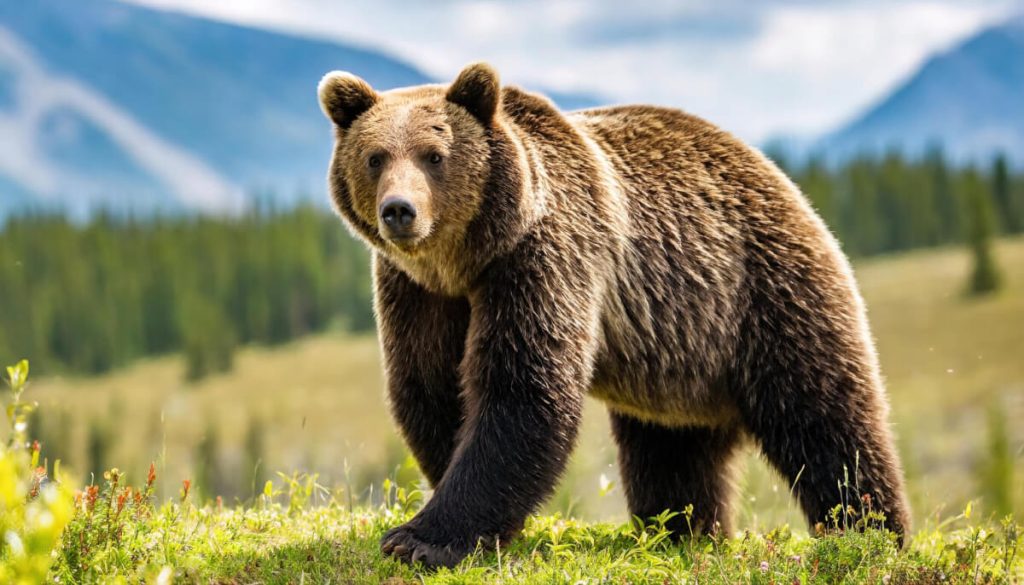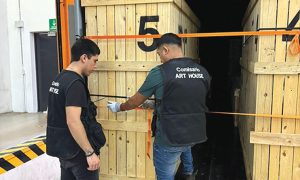

Grizzly bears are a concern for homeowners in the northwestern U.S. and surrounding areas in the northern Rockies. (Chase D’animulls/Shutterstock)
In a nutshell
- Drones achieved a 91% success rate at keeping grizzly bears away from human areas, significantly outperforming traditional guard dogs (57% success), vehicles (85%), and projectiles (74%) in a six-year Montana study
- Modern technology proved safer and more versatile than conventional methods, with drones able to pursue bears across challenging terrain and obstacles that would stop vehicles or dogs, increasing pursuit possibilities by 127%
- Bears showed lasting behavioral changes after being hazed, with older bears requiring less intervention and incidents declining each year – suggesting they learned to avoid human areas over time
MISSOULA, Montana — For centuries, humans have relied on dogs to keep large predators away from their homes and livestock. In Montana’s sprawling prairies, where expanding grizzly bear populations increasingly wander into backyards, researchers have discovered a new way to signal to these beasts that they are not welcome. A six-year study from the University of Montana has found that drones are significantly more effective than guard dogs at keeping grizzly bears away from human settlements.
The grizzly is a formidable predator weighing up to 751 kilograms (1,656 pounds) with 15-centimeter (6-inch) claws and a bite force strong enough to crush bones. Despite their fearsome capabilities, these bears are surprisingly adaptable eaters. They’ll consume everything from wheat to shellfish, which frequently brings them into conflict with human food sources and activities. These conflicts and innovative ways to prevent them are the focus of a new study published in Frontiers in Conservation Science that examines how technology might offer better solutions than traditional deterrence methods.
As grizzly bears in the U.S. continue recovering from near-extinction since gaining protection under the Endangered Species Act in 1975, they’re increasingly venturing beyond their mountainous refuges onto private lands. This expansion back into their historic prairie habitat marks a conservation success story, but it comes with challenges, particularly in North-Central Montana where bears now regularly encounter farms, livestock, and grain crops.
When study author Wesley Sarmento was hired by Montana’s Department of Fish, Wildlife and Parks in 2017 as the first bear manager based entirely on the Great Plains, local residents made their wishes clear during public meetings: they didn’t want bears near homes, in towns, or damaging property and livestock. This led Sarmento to test various hazing methods to deliberately scare bears away from unwanted areas.


His journey to using drones began after a dangerously close call. While attempting to haze an aggressive male grizzly away from a family’s house using traditional firecracker shells, the bear charged at him. Though Sarmento successfully drove it off with a well-placed shot, the incident highlighted the need for safer methods.
Over the next six years, Sarmento conducted 163 different “hazing events” across roughly 28,116 square kilometers of prairie landscape. He tested four different methods: drones equipped with thermal cameras, vehicles (typically off-road capable trucks), specially trained Airedale guard dogs, and various projectiles like rubber bullets and cracker shells.
Drones successfully scared away bears in 91% of attempts, significantly outperforming guard dogs which only succeeded 57% of the time. Vehicles proved effective at 85%, while projectiles achieved a 74% success rate. Perhaps most importantly, drones increased the odds of being able to pursue a bear by 127% compared to vehicle pursuit, as they could easily cross obstacles like canals, fences, and muddy fields.
The Airedale dogs, chosen specifically because local farmers favored the breed, proved disappointing despite their historical popularity. Beyond their lower success rate, they required extensive daily maintenance and training. The dogs often failed to detect bears even at close range, sometimes chasing after feral cats or having dangerous encounters with porcupines that required veterinary care.


Drones, by contrast, offer unique advantages. Their thermal cameras help operators spot bears in thick brush or during cooler weather. Operators can maintain a safe distance while precisely controlling where they want bears to go—a level of accuracy impossible with other methods.
The study also revealed interesting patterns in bear behavior. Most hazing events (74%) occurred during May and June, coinciding with the breeding season when bears are most active and young bears are leaving their mothers. Yearling bears were 2.27 times more likely to require additional hazing compared to adults, suggesting that bears either learn to avoid human areas as they age or that younger bears are naturally more prone to exploration.
Throughout the study period, no bears or humans were injured during any of the hazing events. After being hazed, bears typically fled to locations significantly farther from roads and human development. On average, grizzlies moved 882 meters away from development to 1,193 meters away.
Over time, older bears required less hazing, and the number of incidents declined each calendar year, indicating that bears learned to avoid human areas through these negative experiences. This pattern of aversive conditioning could help prevent future conflicts between humans and bears.
Paper Summary
Methodology
The study documented 163 hazing events between July 2017 and July 2023 across Montana’s northern prairie region. For each encounter, researchers recorded detailed data including the bear’s age, sex, group size, initial behavior, and response to hazing. Success was defined as moving bears at least 200 meters away from their starting location. The team used GPS coordinates and aerial maps to measure distances bears traveled and monitored their flight paths. Four different hazing methods were tested: drones with thermal cameras, off-road vehicles, Airedale guard dogs, and projectiles like rubber bullets and cracker shells.
Results
Drones emerged as the most effective tool with a 91% success rate, followed by vehicles at 85%, projectiles at 74%, and dogs at 57%. Younger bears required more frequent hazing than adults, with yearlings being 2.27 times more likely to need additional hazing compared to adult bears. Most hazing events (74%) occurred during May and June. After being hazed, bears consistently moved to areas farther from roads and human development, increasing their average distance from 882 meters to 1,193 meters.
Limitations
The research was primarily conducted in open prairie environments, which may not reflect how these methods would perform in densely forested areas where drone operation could be more challenging. Not all bears could be individually identified, making it difficult to track long-term behavioral changes in unmarked animals. Weather conditions, particularly high winds and precipitation, sometimes limited drone operations. Additionally, the study couldn’t quantitatively measure how often the drones’ thermal imaging capability proved useful in detecting bears.
Takeaways and Discussion
The research demonstrates that drones represent a safe, effective, and versatile new tool for wildlife management that outperforms traditional methods in many ways. The study suggests that consistent hazing can create lasting behavioral changes in bears, teaching them to avoid human areas over time. The decline in hazing events needed for older bears and the reduction in incidents over each calendar year indicates successful aversive conditioning.
Funding and Disclosures
The research was funded by the United States Fish and Wildlife Service, Montana Fish, Wildlife and Parks, Western Bear Foundation, and Montana Outdoor Legacy Foundation. The drones used in the study were provided by Safari Club International Foundation. The author declared no conflicts of interest.
Publication Information
This study titled “Drones outperform dogs for hazing bears: a comparison of carnivore aversive conditioning tools” was published in Frontiers in Conservation Science on January 27, 2025. The research was conducted by Wesley M. Sarmento of the Montana Department of Fish, Wildlife and Parks.








